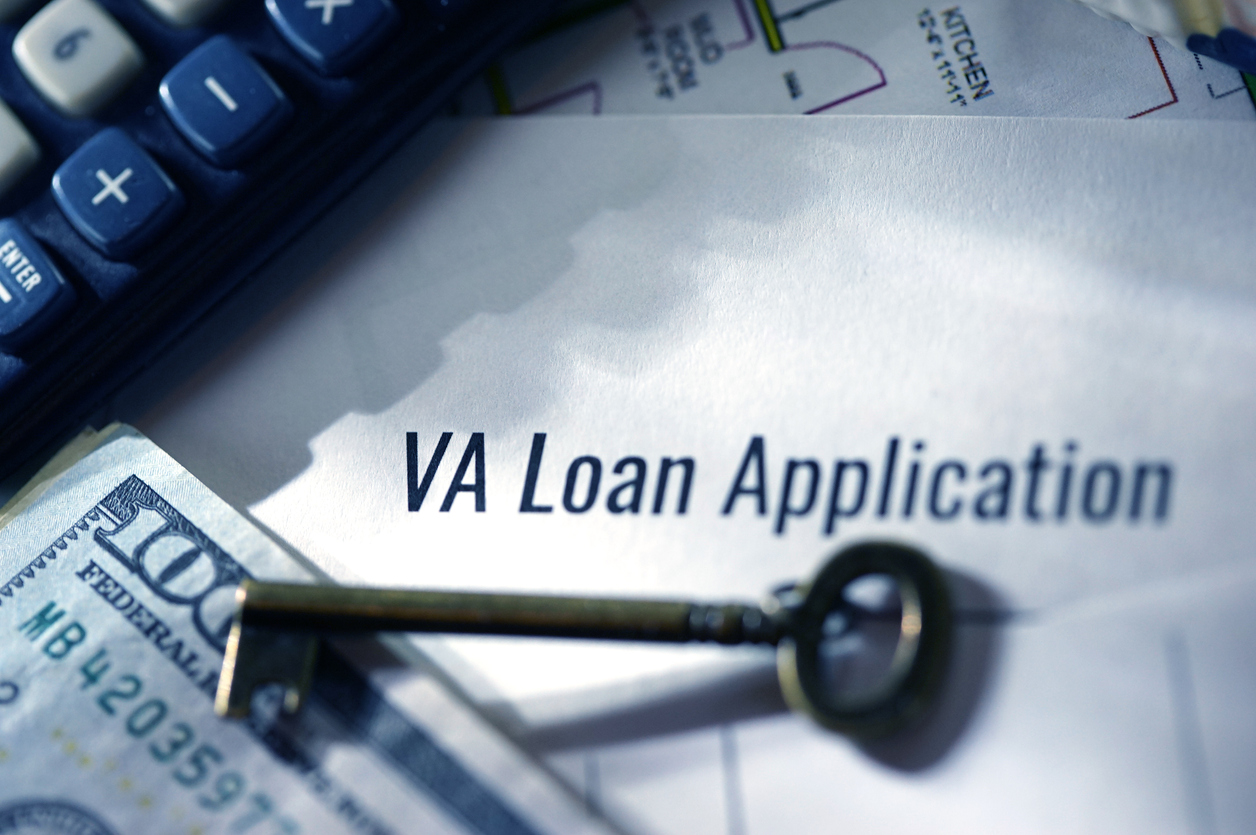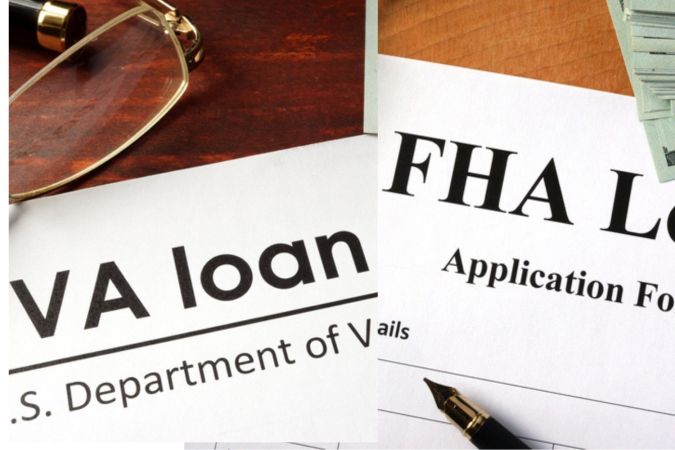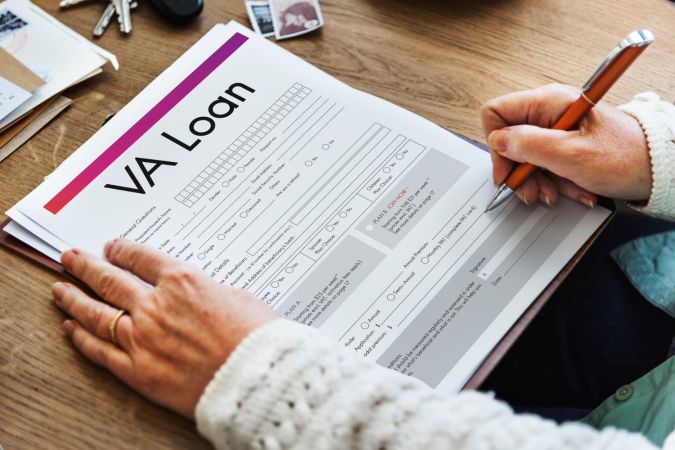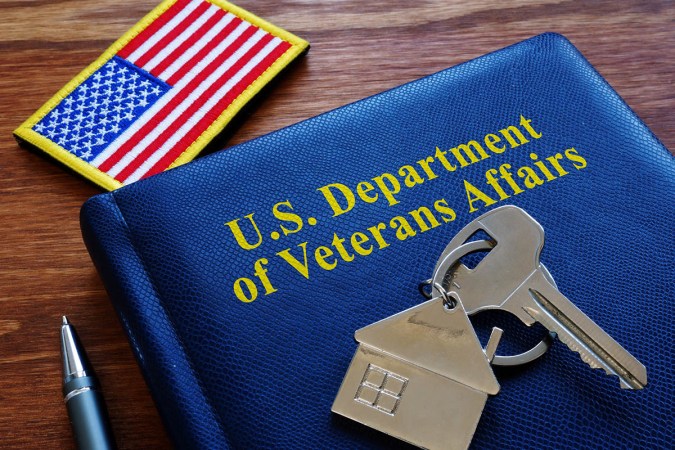We may earn revenue from the products available on this page and participate in affiliate programs. Learn More ›
Home buyers might be surprised to learn how many mortgage options they have when shopping for a new house. Active and former service members, in particular, have several financing options to explore, including home loans backed by the Department of Veterans Affairs (VA). This loan program helps veterans and other qualified military members secure financing to purchase a home while taking advantage of flexible down payment requirements and competitive interest rates. While there are many undeniable benefits to taking out VA home loans, the program’s eligibility requirements restrict access to those who have served or are currently serving in the military, as well as surviving spouses in some cases. As such, it’s always a good idea for home buyers to explore multiple mortgage options to find the right loan for a particular situation. In addition to VA loans for those who qualify, conventional home loans are another option to explore.
What is a conventional loan? Conventional mortgages are home loans that are not insured or guaranteed by the government. They are among the most common types of home financing available, making them a very popular option for house hunters. Understanding the similarities and differences between a VA loan vs. conventional loan can help home buyers find the right mortgage for their next home purchase.
1. Both conventional and VA loans are issued by mortgage companies and lenders, but VA loans are backed by the federal government.
Most home buyers will need a mortgage to purchase a house, and both VA loans and conventional mortgages can provide them with that financing. In addition, both types of home loans are issued by mortgage companies and other lenders such as banks and credit unions. However, VA loans are backed by the federal government, which means that the VA will guarantee a portion of the loan. If the borrower can’t repay their mortgage, the government will repay the lender the guaranteed amount. Government-backed loans such as VA loans and FHA loans lower the lender’s financial risk when extending a mortgage. Since a portion of the loan is guaranteed to be repaid, the lender has more flexibility when offering home loans and may have more lenient financing terms as a result. Conventional loans, on the other hand, are not backed by the government, so lenders assume all financial risks on their own.
2. While most mortgage companies offer conventional home loans, only VA-approved lenders can provide VA-backed financing.
Most mortgage lenders offer conventional loans such as fixed-rate and adjustable-rate mortgages (ARMs). Banks, credit unions, and mortgage companies, for example, typically cater to conventional buyers. However, not all mortgage lenders offer VA loans. Only those lenders that partner with and are approved by the VA can offer VA-backed financing to eligible borrowers. As such, borrowers may find that their preferred lender—their local bank, for example—does not offer VA loans.
On the other hand, some lenders specialize in VA-backed financing, and in some cases exclusively offer VA loans. Because these lenders only work with one particular loan option, they understand the unique challenges and benefits of using the VA loan program. Eligible service members may want to check with these specialty lenders when getting a VA loan for a new house.

3. VA loans are exclusively available to active or former service members as well as surviving military spouses.
When applying for a conventional mortgage, borrowers need to meet certain lender requirements regarding their credit score, debt-to-income (DTI) ratio, and employment status, among other criteria. However, lenders typically don’t consider a person’s vocation when determining eligibility. A VA loan, on the other hand, requires the borrower to meet certain service eligibility requirements. Active-duty and former service members as well as surviving spouses, in some cases, may qualify for the loan program, but anyone else will need to look at other loan options.
Service members who are hoping to use their VA loan benefits may want to first check that they meet the eligibility requirements for VA home loans. Active-duty service members will need at least 90 days of continuous service to qualify for the program. Meanwhile, the length-of-service requirement for veterans and other former military members can vary based on when they served.
4. While VA loans can only be used to finance a primary residence, borrowers can take out conventional mortgages to purchase second homes, vacation houses, and other properties—even real estate investments.
The VA loan program is meant to help veterans and other military members purchase a home in which to live. Therefore, VA-backed financing is only available for the purchase of a primary residence or, in some cases, land to build a house. Service members may need to apply for a VA construction loan if they plan to purchase land and then build their new home using the same mortgage. Borrowers who are looking to buy a second home, investment property, or vacation home will need to consider other mortgage options.
Additionally, the VA doesn’t offer any type of VA business loans for service members who want to buy commercial real estate. Entrepreneurial veterans may be able to secure funding for these kinds of purchases through one of the best small-business loans, though.
Conventional mortgages, on the other hand, can often be used to purchase many different types of property, although it will depend on the lender. Home buyers who qualify for both types of mortgages could potentially use a VA loan to purchase their primary residence and get a separate conventional loan for a vacation home or investment property. However, borrowers will likely need to meet strict credit, income, and DTI-ratio requirements to secure a loan for the second property.

5. Interest rates on VA loans are typically lower than conventional mortgage rates.
One reason many veterans choose the VA loan program is to secure lower interest rates on their mortgages. VA loan rates are often lower than conventional loan rates with the same loan amounts and terms. However, two major factors can affect the actual rate a borrower might receive:
- Their creditworthiness, as reflected by their credit score and DTI ratio, among other factors, and
- The current market rates for mortgage-backed securities.
Loan terms will impact mortgage rates as well. For instance, 15- or 20-year mortgages often have lower interest rates than 30-year loans. In addition, both VA and conventional loans may be offered as either fixed-rate mortgages or ARMs, and that distinction can affect interest rates.
A fixed-rate home loan locks the buyer in at a fixed annual interest rate for the life of the loan. ARMs, on the other hand, start with a fixed-rate period before shifting to a variable rate that fluctuates according to market conditions. For example, a 5/6 ARM will have a fixed rate for the first 5 years of the mortgage. Once the fixed-rate period ends, the mortgage rate will be adjusted every 6 months and may go up or down depending on the market. Even with all of these factors to consider, the best VA mortgage lenders (such as Veterans United and Navy Federal Credit Union) may be able to offer highly competitive interest rates to help lower the total cost of financing.
6. Down payments are not required on VA loans, but borrowers will need to put down at least 3 percent of the purchase price—and likely much more—to qualify for conventional loans.
In addition to enjoying competitive interest rates, borrowers with VA-backed financing can often do so without needing to make a down payment on their VA loans. Down payment requirements will depend on a few conditions, but in many cases, first-time home buyers won’t be asked to put any money down aside from the VA funding fee (described in detail below). Eligible service members may need to put money down if they do not have their full VA loan entitlement, which is the maximum amount that the VA will repay a lender if the borrower defaults on their mortgage. No down payment could mean more cash in a borrower’s pocket to make upgrades or renovations to their new home.
Conventional loan down payment requirements are typically not as lenient for borrowers as VA loan requirements. Mortgage lenders typically require at least a 3 percent down payment for borrowers to qualify for a conventional mortgage, and many will require a much higher amount.

7. Borrowers who put less than 20 percent down on a conventional loan will need to pay private mortgage insurance (PMI) each month; VA loans, meanwhile, never require mortgage insurance.
Although mortgage lenders may offer conventional loans with a 3 percent down payment, the borrower will be required to pay for private mortgage insurance (PMI) to offset the lender’s financial risk. PMI is a type of insurance that helps protect lenders against borrowers who default on their mortgages. Mortgage companies typically require PMI on a loan when the borrower puts less than 20 percent of the purchase price forward as a down payment. Once they have acquired a 20 percent equity stake in the property, borrowers can request to have their PMI removed.
On the other hand, VA loans are guaranteed by the government, so lenders can recoup at least a portion of their losses if a borrower defaults on their mortgage. As such, they don’t require mortgage insurance on VA loans even with the lenient down payment policies.
8. Although borrowers will pay closing costs on both types of loans, those who take out a VA loan will also need to pay a funding fee when they close on their new home.
A lot of behind-the-scenes work goes into buying a property and transferring it to the new owner. During the process, a borrower is likely to incur a handful of expenses, known as closing costs. While closing costs vary based on several factors, home buyers may pay anywhere from 2 to 6 percent of their loan amount in closing costs. Typical closing costs might include:
- Title transfer or deed transfer fees
- Loan origination fee
- Appraisal costs
- Application and underwriting fees
- Government recording fees
- Attorney fees (if applicable)
VA loan borrowers will also usually have to pay a funding fee for their loan. The VA loan funding fee is a one-time payment typically made at closing, although borrowers may be able to roll the cost into their mortgage. The fee helps cover administrative costs related to running the VA mortgage program and varies between borrowers. Borrowers who make a down payment on their VA loan (even if not required to do so) will often pay a lower funding fee.

9. Credit score requirements are often more relaxed for VA loans relative to conventional mortgages but will vary from one lender to another.
Credit score requirements vary from one lender to another. Mortgage companies and other lenders typically set minimum credit scores based on their own internal guidelines—and in many cases, lenders will weigh a prospective borrower’s entire financial situation when determining their eligibility. Having said that, many mortgage companies require borrowers to have at least a 620 credit score to qualify for a conventional mortgage.
The VA, meanwhile, does not set a minimum credit score requirement, so service members may find more flexible eligibility standards when applying for a VA loan compared with the requirements of a conventional mortgage. Like conventional loan requirements, though, VA loan credit score requirements can depend on the lender. Mortgage companies may still require borrowers to have a minimum credit score to qualify for a VA loan, regardless of the VA’s guidelines. Still, some VA-approved lenders may be willing to offer mortgages to borrowers with lower credit scores.
10. While the VA does not set strict debt-to-income (DTI) requirements, conventional mortgage lenders often adhere to the DTI limits set by Fannie Mae and Freddie Mac.
A borrower’s DTI ratio represents the percentage of their monthly income that goes toward debt payments. Lenders use DTI to get a better idea of a borrower’s overall financial situation—in particular, to see how much of their money is tied up in existing debt. A home buyer with a high DTI ratio may not have the financial flexibility to consistently cover their mortgage every month due to their significant debt obligations. As such, they may receive a higher interest rate on their mortgage—assuming their loan application is approved at all. Meanwhile, a low DTI ratio can help a borrower qualify for the best mortgage rate possible.
While VA loans don’t have strict DTI requirements, borrowers with a DTI ratio above 41 percent—meaning they spend more than 41 percent of their gross monthly income on debt payments—will likely face additional scrutiny from their lenders. Lenders often follow the DTI limits set by Fannie Mae and Freddie Mac when considering loan applications for conventional mortgages. Fannie Mae and Freddie Mac are both government-sponsored enterprises that purchase mortgages from lenders, bundle them into mortgage-backed securities, and then sell them on the secondary market.

11. Although lenders will require an appraisal with any home loan, VA-financed purchases may face greater scrutiny due to the VA’s minimum property requirements.
Whether they take out a VA loan or a conventional loan, borrowers will need to pay for a home appraisal. An appraisal helps lenders verify the market value of the property to justify the size of the loan. As such, the outcome of an appraisal could determine whether a loan is approved or not.
The VA loan program typically requires a more thorough appraisal process than what’s required for conventional mortgages. Homes must meet minimum property requirements (MPRs) to qualify for VA-backed financing. VA MPRs are in place to help borrowers find structurally sound homes that are safe for them and their families. These requirements include:
- Stable and durable roofing;
- Clean water supply;
- Electric, heating, and cooling systems in good repair;
- Pest-free environment;
- Space to accommodate the borrower’s immediate family;
- Access from a public street or existing easements for private roads; and
- Sanitary sewage disposal.
Due to the extra scrutiny involved, the appraisal process on a VA loan may take longer than appraisals on conventional loans that are chiefly concerned with the property’s market value. As such, this could lead to longer approval times on VA loans.
12. Active and former service members will likely find VA loans to be more appealing because of the lower interest rates and more flexible financial qualifications. Still, VA eligibility restrictions make conventional loans a better option for more home buyers.
In many cases, a VA loan offers more benefits than a conventional mortgage for eligible service members. With flexible loan requirements and no down payment necessary, many borrowers can get an affordable mortgage through the VA program. However, borrowers who have no service record won’t qualify for a VA loan. Furthermore, those who want to secure financing to purchase a vacation property or second home will need to consider a conventional loan for their home purchase.
It’s always a good idea to compare mortgage lenders and loan products from a variety of sources, regardless of the type of loan that a borrower intends to use. Doing due diligence when shopping for a mortgage gives borrowers the best chance to find the best mortgage lenders and the right loan terms for their situation. Getting loan quotes and reading lender reviews, such as a Rocket Mortgage review, is often a good first step to finding an affordable VA or conventional mortgage.

















